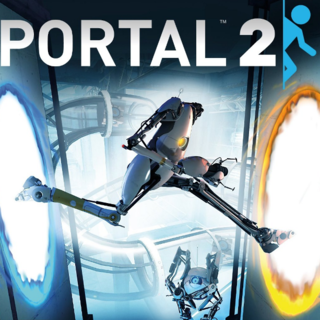Portal 2 is a great sequel to the 2007 innovative concept, with new and welcome elements, but is held back by some flaws
Portal's concept was based on 2005's PC game Narbacular Drop which was developed by students attending DigiPen. Those students later joined Valve and there came the enhanced version of Narbacular Drop. The idea was innovative yet easy to understand. The game gave you a Portal gun allowing you to shoot a blue portal and an orange one at a time onto the wall. If you shoot a second portal onto a another point, the previously shot one of the same color will disappear, so you can only have one blue one and one orange one at a time. When you go into the blue one, you come out from the orange one, vice versa, thus teleporting yourself to complete puzzles, or reaching certain destination.
The puzzles involve some other elements in, such as a button on the ground that can only be pushed down by your own weight or a weighted cube, and after being pushed down, a door will open, allowing proceeding to the next chamber. Another thing included is a energy ball launcher which launches an energy ball literally, and you have to teleport the ball to a "receiver", so that certain mechanism like stairs will be activated, creating the path to the door which you initially couldn't get to.
Portal 2 remains the button thing but excludes the energy ball puzzles, while introducing many new features that are very welcome. Among them there're Propulsion Gel and Repulsion Gel. The function of the former is to give you acceleration while you run on it, and the function of the latter is to offer you a positive pressure which is normal to the ground on which there is the Gel, so as to enable a much more powerful jump once you touch it. And the puzzles always require you to use portals to "spray" these Gels to where you want them. Due to the addition of Propulsion Gel, you're now able to transfer kinetic energy to gravitational potential energy with the aid of the portal gun, which is what you can't do back then in the original Portal. Another addition is Thermal Discouragement Beam. It is always automatically launched via a hole on the wall. You have to use a new type of cube on the six sides of which there are lens allowing you to redirect the beam, or portals, to redirect the beam to some receivers on the walls to get the door open. You can also redirect the beam onto those turrets to get them burned to death. Other than these, there're also Excursion Funnels and Faith Plates which add more fun to the game. All of these new elements are innovative, and create some varied mechanics on different levels.
Another highlight worth mentioning is the co-op mode. It's really one of the reasons that make this a must-play. The puzzles in co-op levels are well designed and really need two persons to finish.
But unfortunately, Portal 2 isn't anything that you can call perfect imo. The single-player campaign has some great design as I said due to these newly included elements. But the game didn't do very well on introducing them to you. Everytime there's a new element, it starts off with an extremely easy puzzle. It sometimes makes you doubt that to introduce them is the sheer purpose for which the dev created those chambers, but apart from it, there's nothing interesting that requires you to use your mind. It's nothing wrong to start the game with that kind of easiness considering some players are new to the franchise, but after the difficulty rises to a certain height, it's odd to decrease the difficulty to zero when a new mechanic is introduced, and that difficulty doesn't have anything to do with the new mechanic. So the game has been largely held back by the unbalanced difficulty progression.
Another problem that I had with the game is, later in the campaign, you'll find yourself leaving test chambers for quite a while as the plot goes on. And then you start solving puzzles in bigger areas. But in these areas, the puzzles require more attention rather than brain, since many of them have the white walls (on which you can create a portal. On black walls, no portal can be created) hidden, often at a very far distance from you, which isn't really a smart design for me.
Despite some mixed reaction that I had with the game design, and the fact that there were some better puzzles in the trailers which haven't appeared in the final game, and that there're too many loading times, Portal 2 is still worth your while if you enjoyed the 1st one.

